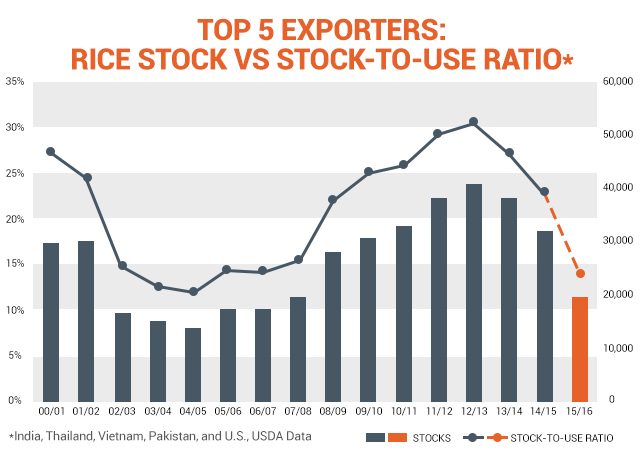SUMMARY
This is AI generated summarization, which may have errors. For context, always refer to the full article.

I hope the newspapers are wrong when they reported that the incoming Duterte administration will recentralize all rice imports under the National Food Authority (NFA) by removing all private sector licenses to imports. The reports also said that the incoming administration will achieve rice self-sufficiency in 3 years.
If this is the case, this will neither represent a change in policy nor progression. In fact, it will be retrogression to the past when the NFA controlled and undertook all rice imports. Because the Philippine government didn’t want to liberalize rice importation, it asked the World Trade Organization for an interim measure of allowing rice imports by the private sector, but with a quantitative restriction. This request was granted twice, but only after sacrificing other agricultural goods whose tariffs had to be brought down faster. The last relief in the abolition of quantitative restrictions was granted by the WTO in 2014, but this will expire in 2017.
I am therefore puzzled as to how the incoming Duterte administration will recentralize all rice imports under the NFA because this would obviously be a violation of our WTO commitments.
However, it’s not only because of the possible adverse consequences of violating our WTO commitments that we shouldn’t recentralize all imports under the NFA or just retain the present policy of quantitative restrictions. It’s also because both policies are plain wrong.
If the incoming Duterte administration’s objective is to make food more affordable, then it should go in the opposite direction and make a real change: abolish the NFA’s rice monopoly, liberalize rice imports, and impose a tariff from 10% to 30%. (I prefer a variable tariff when the tariff goes up during the harvest season and lower during the lean season, but a uniform tariff will also do.)
The biggest benefit from liberalizing rice imports is that it will cause rice prices to drop. Rice prices in Vietnam are about half of what it is domestically. Liberalizing rice importation will enable rice prices to fall because as much cheap rice can be imported from abroad. Presently, the NFA’s monopoly on rice importation and its policy of restricting rice imports keep rice prices high.
Agricultural economist Ramon Clarete says that the average family spends about 20% of its food budget on rice alone. Liberalizing rice imports will enable families to save 10% of their food budget, increasing their disposable income.
The average rice consumption is 120 kilos per person. Assuming just savings of P10 per kilo, the net consumer welfare benefit for 100 million Filipinos is about P120 billion, or more than what the government spends on the Conditional Cash Transfer (CCT) or Pantawid Pamilyang Pilipino Program (4Ps). Liberalizing rice imports will have a greater consumer welfare benefit than the 4Ps, and without a costly administrative bureaucracy to boot.
There are other benefits. It will reduce the demand for higher wages and make Filipino labor more competitive. It will reduce graft and corruption in the Department of Agriculture (DA) and the NFA. Import licenses are usually handed out to favored importers. Kickbacks are present in all aspects of rice importation and distribution, from shipping and trucking to warehousing.
Pity the poor rice farmers if imports are liberalized – that’s the usual refrain of those who want the NFA to retain its rice importation monopoly (usually the grafters in DA).
First, with the huge difference between the domestic price of rice and the imported price of rice, there’s a great incentive to smuggle. In fact, rice smuggling is rampant and deprives the government of revenues.
Second, many poor rice farmers are net consumers of rice – eating only what they produce during the harvest season, and buying rice the rest of the year. The Kidapawan farmers in North Cotabato were demanding rice because the overly dry conditions of El Niño prevented them from producing enough rice for themselves. Instead, their demands were met with bullets. These poor rice farmers will benefit from rice import liberalization.
Third, our rice farmers, those who have learned to adopt new technology and are not restrained by CARP from leasing more lands, are efficient and can compete. This much we can glean from a study by the International Rice Research Institute (IRRI) – Changes in Rice Farming in the Philippines: Insights from Five Decades of a Household-level Survey.
Lastly, we can use the tariff revenue from liberalized rice imports to directly aid rice farmers to either improve their productivity or shift to more high-value crops. As it is, the subsidy to the NFA just goes to the pockets of officials and unscrupulous rice traders and none directly to farmers.
What about food security? Well, what matters is income security, not rice self-sufficiency. We can rely on international trade to guarantee our food security. For example, the Economist Intelligence Unit rated Singapore the second most food secure nation in the world, after the United States, when it doesn’t have agricultural farms. Malaysia also has a deliberate policy of relying on imports for up to 30% of its requirements.
Moreover, we are fortunate that the two biggest rice exporting nations in the world, Thailand and Vietnam, are our fellow members in the ASEAN. We can forge treaties with them to give us assurance of rice supply in case of a global shortage.
Indeed, a global shortage of rice is coming, according to the IRRI (see graph). If this is so, the incoming Duterte administration will be severely tested early on.

If the incoming Duterte administration retains the present policy of an NFA monopoly, we can possibly see a repeat of 2007-2008 when the NFA drove up the worldwide price of rice by panic buying. Of course, there was also an incentive for the NFA to import lots of rice at high prices.
The NFA is too slow and too burdened by government regulations to quickly respond to the market. It can’t be relied on to quickly increase import quotas when the market conditions are signaling a shortage. This is why it’s best for the private sector to be free to import. It’s in their self-interest to buy rice as cheaply as possible and to make rice available when there’s a shortage so as to make a profit.
What about rice self-sufficiency? Bad idea. The Aquino administration failed miserably, despite pouring billions into its much-ballyhooed rice self-sufficiency program. Agriculture Secretary Prospero Alcala kept promising that the country would be self-sufficient in rice in 2014 and 2015 and each time he had to eat his own words.
What’s worse is that the Aquino administration cruelly raised the domestic price of rice by restricting imports in order to depress demand so that it could claim equality between supply and demand.
Rice economist Roehl Briones was already saying as far back as 3 years ago that the administration’s rice self-sufficiency program was impractical and unrealistic, based on overly optimistic assumptions about increases in productivity and stagnant demand for rice even with population growth.
However, the Aquino administration paid no heed. It’s highly probable that the rice self-sufficiency program was just a pretext to justify the billions in contracts awarded purportedly to achieve rice self-sufficiency.
According to agri-business economist Rolly Dy, agriculture posted a measly 1.5% average annual growth under President Benigno Aquino III, lower than population growth, compared with 2.8% average growth under former president Gloria Macapagal Arroyo even if the DA under Aquino had thrice the budget.
President-elect Rodrigo Duterte promised change. He should start with our current failed rice policy to make food more affordable. He should abolish the NFA rice import monopoly, liberalize rice imports, apply a moderate tariff on rice imports where the revenues will go to rice farmers directly, redirect the DA budget toward higher value crops away from rice, and quickly establish agreements or treaties with our fellow ASEAN members Thailand and Vietnam regarding rice security. – Rappler.com
Calixto V. Chikiamco is the president of the Foundation for Economic Freedom.
Add a comment
How does this make you feel?
There are no comments yet. Add your comment to start the conversation.